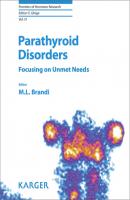Parathyroid Disorders. Группа авторов
Чтение книги онлайн.

Читать онлайн книгу Parathyroid Disorders - Группа авторов страница 4
Название: Parathyroid Disorders
Автор: Группа авторов
Издательство: Ingram
Жанр: Биология
Серия: Frontiers of Hormone Research
isbn: 9783318064094
isbn:
Causes related to drugs include the following:
– Thiazide diuretic use (see above).
– Vitamin A intoxication (see above).
Primary Hyperparathyroidism
The 4 parathyroid glands derive from the third and fourth pharyngeal pouches and descend caudally to the anterior neck. They are embedded in the posterior thymus, with ectopic locations occurring as well. Through the secretion of PTH, the parathyroid glands are primarily responsible for maintaining extracellular calcium and phosphate concentrations. PTH is secreted in 3 distinct ways: tonic secretion, circadian dynamics (with the highest amount secreted in the morning and lowest in the evening), and a pulsatility that appears to be stochastic (occurring unpredictably, 10 or more times a day). Most PTH is secreted continuously [6, 13, 14]. It has well-described effects on bone, kidney, and intestine, which play a role in controlling serum calcium and phosphate levels [1]. PTH is a central regulator of bone homeostasis, through its action on bone-forming osteoblasts, osteocytes, and bone-resorbing osteoclasts [4]. The final effect of PTH on bone mass is either anabolic or catabolic, and will depend on the dose and periodicity of PTH signaling [6]. In the kidney, the effects of PTH are targeted to enhance synthesis of active vitamin D, 1,25(OH)2D3, enhance tubular calcium reabsorption, a calcium-conserving property, and enhance phosphate excretion, a phosphaturic property [6].
PHPT is a common disorder of mineral metabolism that is due to excessive secretion of PTH from 1 or more of the 4 parathyroid glands. The clinical consequences of abnormally active parathyroid tissue are typically hypercalcemia and concentrations of PTH that are either clearly elevated above the normal range or inappropriately normal in the context of hypercalcemia.
Epidemiology
PHPT mainly affects women, with a female to male ratio of 3–4:1 [2, 3]. When the first several hundred individuals with PHPT were described in the 1930s at Massachusetts General Hospital, 57% had kidney stones, 8% had peptic ulcer disease, and 23% had bone complications [4]. Over the past 5 decades, the clinical presentation of PHPT has changed in several regions of the world. The clinical evolution of PHPT from symptomatic to asymptomatic has occurred primarily in the USA and Europe, although other countries have more recently appreciated this change as well. Similar to the epidemiology in North America, PHPT in Europe most often presents as an asymptomatic disorder. Both in Sweden and Denmark, the incidence of PHPT appears to be increasing, perhaps because of an increase in the use of screening methods [6, 15, 16].
Etiopathogenesis and Diagnosis
PHPT is most commonly due to a single benign parathyroid adenoma (approximately 80% of patients), with multiglandular disease seen in approximately 15–20% of patients [6]. PHPT is due to multiglandular involvement consisting of either multiple adenomas or hyperplasia of all 4 glands (5–10%), and very rarely by parathyroid carcinoma (<1%) [4]. Very rarely, PHPT may be caused by ectopic secretion of PTH by a nonparathyroid tumor. In most patients with PHPT, the disease is sporadic, without a personal or family history of PHPT [6, 17]. The genetic syndromes associated with PHPT are considered major risk factors and include MEN1, 2A, and 4, hyperparathyroidism-jaw tumor syndrome, familial isolated PHPT, familial hypocalciuric hypercalcemia (FHH), and neonatal severe hyperparathyroidism [6]. The combination of hypercalcemia and an elevated or inappropriately normal PTH level makes PHPT the most likely diagnosis [18]. The genetics of PHPT is usually monoclonal when a single gland is involved, which implies that the tumors derive from a single abnormal cell [4], and polyclonal when multiglandular disease is present. The genes that have been implicated in PHPT include proto-oncogenes and tumor-suppressor genes [4]. Hyperplastic parathyroid glands probably originate from a stimulus for generalized (polyclonal) parathyroid cell proliferation, even though monoclonal tumors may also occur in this context. Thus, in some cases, apparently hyperplastic glands are in fact adenomas. The clonality of parathyroid tumors has also been shown in MEN1 [4].
If the corrected serum calcium is normal and PTH is elevated, serum ionized calcium should be measured, as PHPT can present with an elevated ionized calcium despite a normal albumin-adjusted serum calcium [18, 19]. Ionized calcium measurements are reliable if samples are collected under anaerobic conditions maintaining the original pH of the specimen, as acidosis is associated with an increase in ionized calcium. The differential diagnosis of hypercalcemia includes conditions which mimic PHPT, including FHH and certain non-PTH-related forms of hypercalcemia (see above in the section Hypercalcemia and Differential Diagnosis). An elevated serum PTH in the presence of consistently normal albumin-adjusted calcium and ionized calcium, normal serum 25-hydroxyvitamin D [25(OH)D >20 ng/mL or 50 nmol/L], and well-maintained renal function (eGFR >60 mL/min/1.73 m2) supports this diagnosis [18, 19]. In the evaluation of PHPT, the calcium to creatinine clearance ratio is determined in order to exclude FHH, a rare, autosomal-dominant disorder with 3 identified variants with very low urinary calcium excretion and mild hypercalcemia with normal or slightly elevated PTH levels. FHH1 is due to an inactivating mutation of the calcium-sensing receptor (CaSR) gene. FHH2 is caused by inactivating mutations of the G-protein alpha 11 subunit (Gα11), and FHH3 is due to inactivating mutations of the adaptor protein-2 sigma subunit (AP2S1) [18, 20, 21]. Urinary calcium excretion is usually expressed as the “calcium clearance to creatinine ratio” (CCa/CCr), which is rather the sensitive index of renal calcium excretion than total urinary calcium. The CCa/CCr in FHH is usually less than 0.01, allowing discrimination from PHPT [11, 21]. However, СКАЧАТЬ